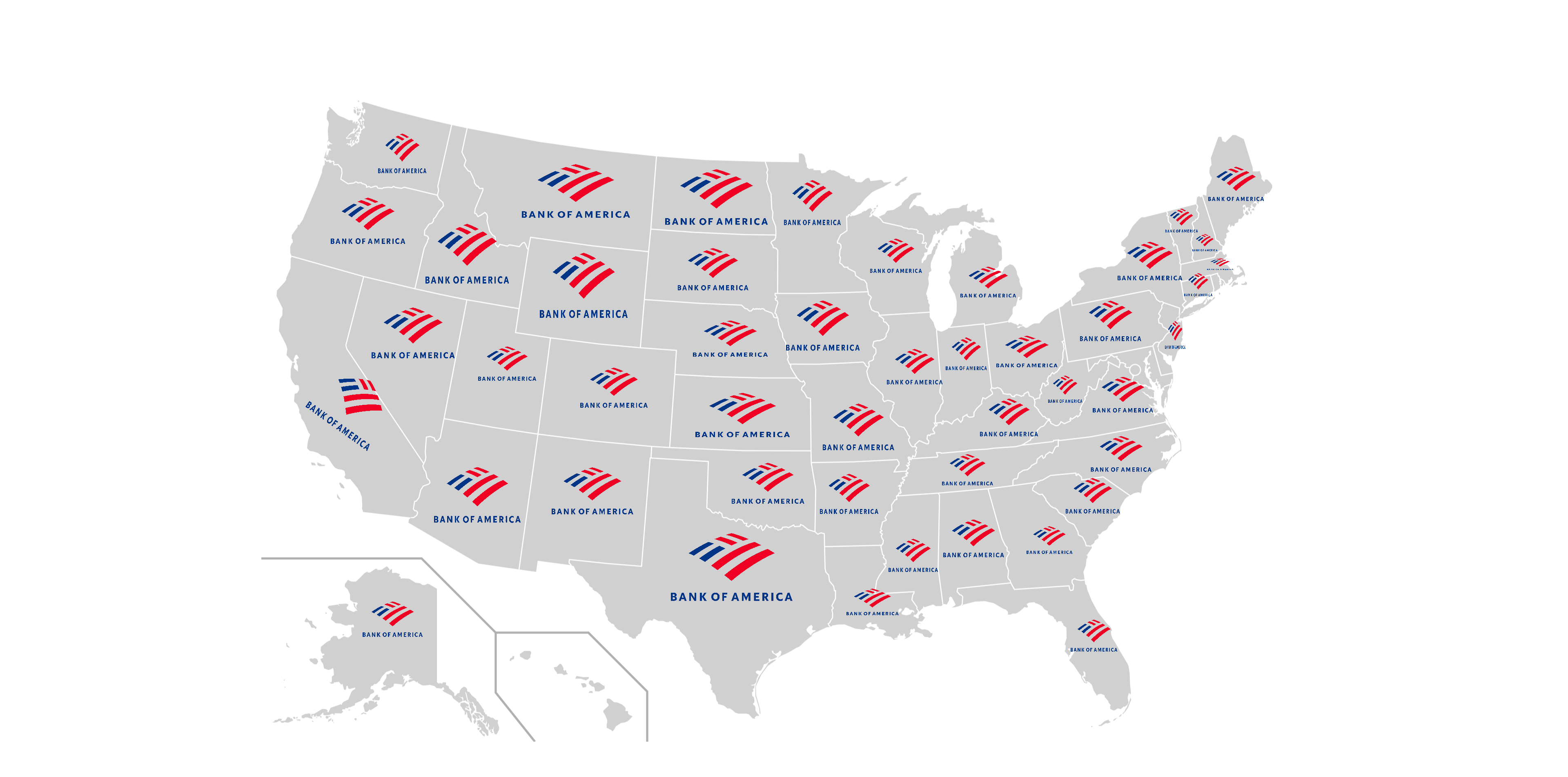
Expansion Potential Effects on Bank of America BAC Stock
Bank Of America BAC Embarks on Expansion Amid Predicted Mild Recession: A Look at the Possible Impacts on its Stock Value | That's TradingNEWS
Bank of America (BAC) has been making notable strides in the market, demonstrating resilience even amid turbulent economic times. This resilience stems from the bank's extensive valuation ranking system, a proprietary scoring methodology that assesses the company's overall health based on its stock price, earnings, and growth rate. It is worth noting that BAC presently holds superior value compared to 90% of stocks based on these metrics, offering promising potential for long-term investors.
The current trading price of BAC is below the historical average PE ratio of roughly 15, standing at 7.7, which signifies that investors are currently paying less for its earnings. Further substantiating this perspective, the bank's trailing-12-month earnings per share (EPS) of 3.33 justifies its market trading value. While trailing PE ratios often overlook a company's projected growth rate, BAC's projected growth rate has been factored into its 12-month-forward PE to Growth (PEG) ratio, which stands at a reasonable 1.17. The PEG ratio, arguably one of the most utilized valuation metrics, provides a balanced perspective on a company's overall health, focusing on its future growth prospects.
As part of a strategic move to expand its footprint and tap into new markets, Bank of America has announced plans to open new branches in four additional U.S. states - Nebraska, Wisconsin, Alabama, and Louisiana. This would place the bank in direct competition with JPMorgan Chase & Co, the largest U.S. lender, bringing BAC's retail presence to 39 states, as compared to JPMorgan's 49. The move has been buoyed by the bank's strong performance, particularly in the consumer banking segment, which accounted for 38% of BAC's net income in the first quarter.
A key part of this expansion plan involves creating a unified service experience by integrating banking, lending, and brokerage services under one roof. In the words of CEO Brian Moynihan, "By expanding our capabilities in these markets, we are able to better serve clients, and help drive local community growth."
Despite the bank predicting a "mild recession" for the U.S. in the early part of the following year, its continued growth strategy illustrates a confident outlook. The bank's network has shrunk from 6,100 branches to 3,800 over the past decade, yet its consumer deposits have almost doubled to $1 trillion. A significant aspect of BAC's strategy involves renovating locations to accommodate larger waiting areas and office spaces for client meetings.
The resilience of Bank of America is reflected in the bank's gross profit, which was $26.258 billion for the quarter ending March 31, 2023, marking a 13.04% increase year-over-year. Additionally, the annual gross profit for 2022 was $94.95 billion, a 6.55% increase from the previous year. The revenue for the same quarter was $40.465 billion, a substantial 64.83% increase year-over-year.
Despite a 17% dip in the bank's stock in 2023, making it one of the most sold stocks amongst its U.S. megabank peers, the bank has weathered the storm of the short-lived banking crisis earlier in the spring. Amid rising interest rates, declining deposit levels, and increased competition, Bank of America continues to hold its ground due to its diversified deposit base, including 36 million checking accounts with more than $600 billion in deposits.
The expansion plan for 2023 includes the addition of financial centers in new states and markets. This includes two financial centers in Omaha, five in Louisville starting in 2024, and financial centers in Boise, Birmingham, Madison, New Orleans, Milwaukee, Dayton, and Huntsville in to:In evaluating the performance and overall health of a company, several key metrics come into play. Bank of America (BAC) scores admirably on many of these fronts, with the bank's current stock price, earnings, and growth rate offering superior value to 90% of stocks according to a proprietary scoring system. This robust valuation is particularly appealing to long-term investors who are focused on buy-and-hold strategies.
The bank's trailing-12-month Price to Earnings (PE) ratio stands at 7.7, lower than the historical average of around 15. This suggests that investors are paying less than the company's worth relative to its earnings, indicating that BAC offers good value at its current trading price. The trailing-12-month earnings per share (EPS) of 3.33 certainly corroborate the bank's market standing. However, trailing PE ratios fail to account for a company's projected growth rate, hence some firms might exhibit high PE ratios due to potentially attractive high-growth prospects, despite their current earnings being low.
Looking forward, BAC's 12-month-forward PE to Growth (PEG) ratio is 1.17, which is considered an average value, reflecting that the market's valuation of BAC is in line with its projected earnings growth. PEG ratios, which consider a company's future growth rather than past performance, are widely used by analysts today as they encompass more fundamentals of a company's overall health.
Watch Real Time Bank Of America Stock Price (NYSE:BAC)
In a move designed to further consolidate its standing, Bank of America has announced plans to expand its consumer branches into four new U.S. states - Nebraska, Wisconsin, Alabama, and Louisiana. These new financial centers, which will be part of a four-year expansion across nine markets, including Louisville, Milwaukee, and New Orleans, will enhance BofA's retail presence to 39 states. In comparison, the largest U.S. lender, JPMorgan Chase & Co, has branches across 49 states.
This expansion is indicative of the strong performance of both banks, buoyed by resilient consumers and small businesses, and the increasing income from clients' interest payments as the Federal Reserve continues to raise borrowing costs. Indeed, consumer banking constituted 38% of BofA's net income in the first quarter. The new branches aim to integrate banking, lending, and brokerage services, thereby enhancing the customer experience.
According to CEO Brian Moynihan, the expansion is about more than just the bottom line: "By expanding our capabilities in these markets, we are able to better serve clients, and help drive local community growth." These comments were made despite the bank predicting a "mild recession" for the U.S. in the early part of next year, expecting two quarters of negative growth. With inflation remaining higher than the Federal Reserve's target, Moynihan anticipates the central bank will need to continue raising rates.
Despite the predicted economic downturn, the bank has seen significant growth in consumer deposits. Over the last decade, BofA's network has contracted from 6,100 branches to 3,800, while its consumer deposits have almost doubled to $1 trillion. To cater to evolving customer needs, the bank is renovating locations with larger waiting areas, office spaces for client meetings, and less conspicuous teller windows. These changes are in response to a 50% decrease in foot traffic for transactions from 2019, countered by a 90% surge in appointments.
"We have put in place almost 30,000 bankers and specialists that help clients every day with their life priorities," explained Aron Levine, the bank's president of preferred banking. This proactive approach has been echoed by Holly O'Neill, Bank of America's president of retail banking, who anticipates strong performance for the unit in the second quarter.
The resilience to: Assistant<|im_sep|>The robust scoring system of Bank of America Corp (BAC) analyses its stock price, earnings, and growth rate, taking into account the overall health of the company. Currently, BAC holds a better value than 90% of stocks based on these metrics, which is most relevant for long-term investors focused on buy-and-hold strategies. BAC's trailing-12-month Price to Earnings (PE) ratio of 7.7 falls below the historical average of approximately 15, suggesting that at its current trading price, investors are paying less in relation to the company's earnings. The trailing-12-month earnings per share (EPS) of 3.33 justify its current trading rate in the market. Nonetheless, trailing PE ratios do not factor in a company's projected growth rate.
Looking at BAC's 12-month-forward Price Earnings to Growth (PEG) ratio of 1.17, the market is valuing BAC right in line with its projected earnings growth. This value is considered roughly average, with the PEG ratio derived from its forward price to earnings ratio divided by its growth rate. A PEG ratio of 1 indicates a perfect correlation between earnings growth and share price, making PEG ratios a popular valuation metric among analysts due to their focus on a company's overall health and future prospects.
BAC's announcement on Tuesday of expanding consumer branches into four new U.S. states, namely Nebraska, Wisconsin, Alabama, and Louisiana, signals a strategic move to increase its national footprint. The new financial centers, part of a four-year expansion across nine markets, aim to consolidate banking, lending, and brokerage services under one roof, thereby enhancing BAC's retail presence across 39 states.
With consumer banking accounting for 38% of BAC's net income in the first quarter, the new branches are designed to serve clients better and stimulate local community growth, according to CEO Brian Moynihan. This expansion comes despite the bank's prediction of a "mild recession" for the U.S. in the upcoming year, which Moynihan attributes to inflation levels exceeding the Federal Reserve's comfort zone. Consequently, he anticipates the central bank will continue to raise rates.
Over the past decade, BAC's network has contracted from 6,100 to 3,800 branches. Meanwhile, its consumer deposits have almost doubled to $1 trillion. The bank is redesigning its locations with larger waiting areas and office spaces for client meetings, while deemphasizing teller windows, mirroring a 50% drop in foot traffic for transactions since 2019. Nevertheless, appointment numbers have surged by 90%.
How Expanding Potentially would Effect Bank Of America Stock (NYSE:BAC)
While Bank of America (BAC 0.98%), the second-largest bank by assets in the U.S., has seen its stock decrease by roughly 17% in 2023, a higher rate than its large U.S. megabank peers, there are several reasons for long-term optimism.
Earlier in the year, a brief banking crisis prompted investors to shift their outlook for BAC as they reevaluated their expectations for funding costs and bank balance sheets. The crisis was triggered by a confluence of factors, including rapidly rising interest rates, dwindling deposit levels, quantitative tightening, and increased competition. As these elements forced failed banks to sell bonds at a loss to cover deposit outflows, investor concern over bank bond portfolios escalated.
BAC found itself caught in this scenario after investing many of its excess deposits in low-yielding, longer-term bonds just before the Fed initiated a series of interest rate hikes in early 2022. By the end of Q1 2023, the bank reported over $99 billion of unrealized losses in its held-to-maturity bond portfolio, with intentions to hold these bonds until maturity. However, if a substantial number of customers were to withdraw their deposits, BAC would have to sell these bonds at a loss, affecting the bank's earnings and capital levels.
Despite these challenges, BAC has weathered the storm due to its diversified deposit base, which includes 36 million checking accounts with more than $600 billion in deposits. According to the bank's Chief Financial Officer, Paul Donofrio, these checking account deposits are "very stable and cost less than one basis point," indicating that they are less likely to be withdrawn than higher-cost deposits.
In addition to its resilient deposit base, the bank's income from trading operations and other non-interest revenue sources has helped offset the lower net interest income resulting from the flatter yield curve.
Moreover, Bank of America's resilience is reflected in the bank's gross profit, which amounted to $26.258 billion for the quarter ending March 31, 2023, marking a 13.04% increase year-over-year. The annual gross profit for 2022 was $94.95 billion, which is a 6.55% increase from 2021. Revenue for the quarter was $40.465 billion, a substantial 64.83% increase year-over-year.
Looking ahead, the bank is continuing its expansion plans for 2023, which include adding financial centers in new states and markets. This includes two financial centers in Omaha, five in Louisville starting in 2024, and financial centers in Boise, Birmingham, Madison, New Orleans, Milwaukee, Dayton, and Huntsville in the next four years.
















